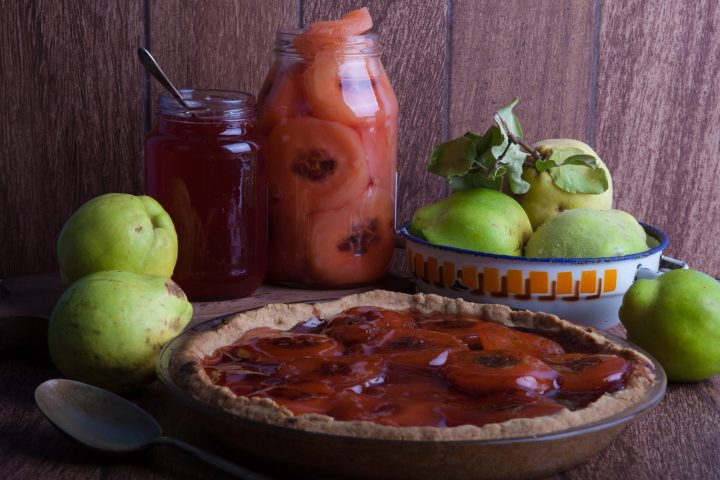MAIN INGREDIENT
Season of the Quince

The quince is believed by some scholars to be the Forbidden Fruit of the Garden of Eden. Take that, apples.
Tony Jackman supports Isabelo. You can too, here
Find Tony’s Karoo Heartland quince tart recipe here
A quince is a bit of an Ugly Sister. Throughout the long hot summer of the Platteland they grow slowly on trees, somewhat scruffy, mottled, even a little furry, while nearby the pomegranates simper prettily on their branches, fully expecting to be invited to twirl and bop when the time comes to dance at the harvest ball. Even when she’s ripe the quince is hard and uninviting and will not be sampled at all without first being given plenty of attention in the kitchen.
This is where your tuisnywerheid comes in. If you live in a small town there is almost certain to be one of these eclectic country stores somewhere in town, its shelves packed with jars of pickles and preserves, jams, relishes and chutneys. You’ll most likely find that there are numbers, each number belonging to a particular tannie in town or on a farm in the vicinity who toils in the early hours at her particular home industry (that’s what tuisnywerheid means), baking cakes and rusks and biscuits and fudge and making preserves from whichever fruit has lately come into season. She will drive into town to the tuisnywerheid shop with them or send them in with her husband when he goes in to buy pellets.
Right now, aunties everywhere, and some uncles too, are toiling at the stove to make preserves of quince, only weeks after having made fig jam and, before that, jams and chutneys using the stone fruits; the peaches and the plums, the apricots and the nectarines. Not too long from now, as we move into winter, the citrus will come to the fore. Already, in Cradock, there are early ripening tiny varieties of naartjies. Lemons and oranges are turning now from green to yellow, and the sun will soon be burnishing the oranges to the colour they are known by.
Once the lemons and oranges have ripened, the big pots will come out again, the sugar and lemon (because you use it in other jam making too, even in orange marmalade), and much water of course, and there will be much bubbling and burbling on stove tops as marmalades are made; lemon, orange, grapefruit, occasionally lime, “three fruit”, some even made a little tipsy with alcohol. One favourite of mine from these parts has whisky in it. Reputations are made and can fall on the quality of a tuisnywerheid’s doughty suppliers, operating as they do mostly out of sight in their private kitchens and mysterious worlds, just as chefs need much enticing out of the kitchen.
But the quince has a surprisingly broad application and is not merely confined to preserves and jellies. C Louis Leipoldt expounded the virtues of a quince bredie, which he described as “interestingly quaint” and was made with “half a dozen quinces”, ribs of mutton, onions, cloves, ginger and mace (all very typical of old Cape colonial stews), rosemary and (unspecified) wine. Quince rice was made with precooked rice, grated green quince “and some pounded cheese”, pepper, salt, chilli, onion juice and a glass of sherry, and steamed. It’s hard for our palates to understand quite what cheese has to do with all that, but there’s old Cape cookery for you.
The French make a cheese of it called pâte de coing, though it is more like a thick jelly. Mexico, Spain and certain other Latin countries have a similar tradition: a thick quince paste called membrillo. Argentina has a tradition of a quince lattice pie called pasta frola and in Portugal a quince jam is made called marmelada although the name comes from marmelo, Portuguese for quince, and is a tradition going back 500 years. Sicilians make cotognata, a quince jam, and they’re adored in Turkey, where ayva tatlisi is a traditional syrupy poached quince dessert.
Back home, SJA de Villiers’ Cook & Enjoy offers a savoury quince sauce that begins with quince jelly (that is, the jelly becomes the key ingredient of another sauce) which is melted in a double boiler, after which a beaten egg yolk, vinegar, mustard powder, salt and pepper are whisked into it. Horseradish sauce or chutney are optional extras.
In the current quince season, Cradock’s Heyla Meyer, whose products now sell widely in the Eastern Cape and beyond, typifies the entrepreneurial spirit of the best of these jam makers and preserve artists. This week I bought her preserved quince slices, beautifully pink thanks to the cooking method (quince flesh is naturally off-white but turns pink and later red if cooked for long enough), and her exquisite quince jelly, crystal clear in its cerise beauty. I used both of them to conjure up a quince tart which I hoped would do justice to the product. DM/TGIFood





 Become an Insider
Become an Insider
Comments - Please login in order to comment.